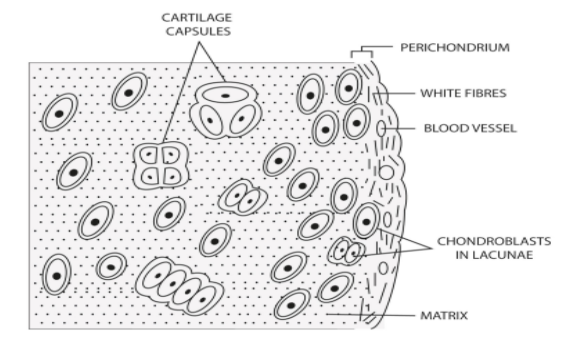
Draw a neat labelled diagram of Hyaline Cartilage.
Answer
564k+ views
Hint: Cartilage is the kind of animal tissue found in areas like the nose, ears, and trachea of the physical body. A type of cartilage found on many joint surfaces; it contains no nerves or blood vessels, and its structure is comparatively simple.
Complete answer:

Additional Information:
-The cartilage is the tissue that is rigid and flexible than the bones and the muscles.
-The cartilage consists of various fibres including collagen, elastin, proteoglycans, and glycosaminoglycans.
-It is mostly found in the area around the ribcage, ear, nose, bronchi, etc.
-They sometimes hold body tubes due to the presence of collagen fibres.
-Cartilages are of three types: elastic cartilage, headline cartilage, and fibrocartilage.
-The cartilages vary depending upon the presence of collagen and proteoglycan.
-The blood vessels and nerves are not present inside the cartilage.
-By the process of diffusion through chondrocytes, nutrition is supplied to the body.
-It is mesodermal in origin which is derived from the mesoderm germ layer during embryogenesis.
-The cartilage shows very little repair capabilities.
-The cartilage cannot be observed simply by X-rays, it requires dye to stain then only it will appear on the X-ray.
Note: -The cartilage was first observed and discovered during the fourth century by Aristotle (384-322). The word cartilage was derived from the French and English word cartilage, meaning ‘cartilage’. In medical science, the word ‘chondro' is used to describe the cartilage. The cartilage is made up of chondroblasts cells and chondrocytes along with the matrix containing 10% aggrecan, 75% water, and a mixture of collagen and other substances.
-Bones such as ribs and cranial bones are protective structures for critical organs such as the brain, spinal cord, heart, and lungs. Bones are relatively inflexible than cartilage. Cartilages are also found in the covering of the ends of long bones in the synovial joints as articular cartilages. The smooth and slippery texture of the cartilage helps minimize friction in joints.
Complete answer:

Additional Information:
-The cartilage is the tissue that is rigid and flexible than the bones and the muscles.
-The cartilage consists of various fibres including collagen, elastin, proteoglycans, and glycosaminoglycans.
-It is mostly found in the area around the ribcage, ear, nose, bronchi, etc.
-They sometimes hold body tubes due to the presence of collagen fibres.
-Cartilages are of three types: elastic cartilage, headline cartilage, and fibrocartilage.
-The cartilages vary depending upon the presence of collagen and proteoglycan.
-The blood vessels and nerves are not present inside the cartilage.
-By the process of diffusion through chondrocytes, nutrition is supplied to the body.
-It is mesodermal in origin which is derived from the mesoderm germ layer during embryogenesis.
-The cartilage shows very little repair capabilities.
-The cartilage cannot be observed simply by X-rays, it requires dye to stain then only it will appear on the X-ray.
Note: -The cartilage was first observed and discovered during the fourth century by Aristotle (384-322). The word cartilage was derived from the French and English word cartilage, meaning ‘cartilage’. In medical science, the word ‘chondro' is used to describe the cartilage. The cartilage is made up of chondroblasts cells and chondrocytes along with the matrix containing 10% aggrecan, 75% water, and a mixture of collagen and other substances.
-Bones such as ribs and cranial bones are protective structures for critical organs such as the brain, spinal cord, heart, and lungs. Bones are relatively inflexible than cartilage. Cartilages are also found in the covering of the ends of long bones in the synovial joints as articular cartilages. The smooth and slippery texture of the cartilage helps minimize friction in joints.
Recently Updated Pages
Why are manures considered better than fertilizers class 11 biology CBSE

Find the coordinates of the midpoint of the line segment class 11 maths CBSE

Distinguish between static friction limiting friction class 11 physics CBSE

The Chairman of the constituent Assembly was A Jawaharlal class 11 social science CBSE

The first National Commission on Labour NCL submitted class 11 social science CBSE

Number of all subshell of n + l 7 is A 4 B 5 C 6 D class 11 chemistry CBSE

Trending doubts
10 examples of friction in our daily life

One Metric ton is equal to kg A 10000 B 1000 C 100 class 11 physics CBSE

Difference Between Prokaryotic Cells and Eukaryotic Cells

1 Quintal is equal to a 110 kg b 10 kg c 100kg d 1000 class 11 physics CBSE

State the laws of reflection of light

Explain zero factorial class 11 maths CBSE




